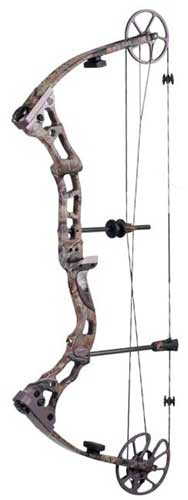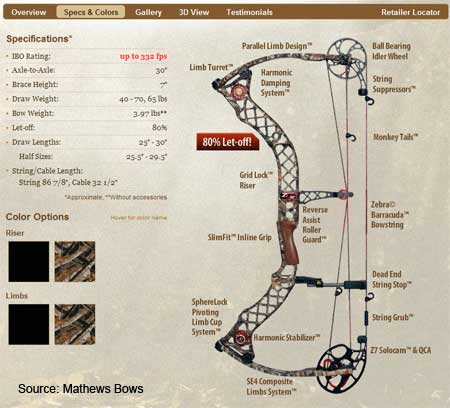Choosing a Compound Bow
by Brian Wensel
 Rule number one; do not “out bow” yourself. You do not need to shoot a 70 or 80-pound bow to successfully take a whitetail. I have hunting bows that range from 50 to 70-pounds and setups that are geared toward specific hunting situations. For the majority of deer hunters, a 60-pound compound bow at ranges out to about 30 or 35 yards is more than adequate. If you are planning to hunt in the Midwest for elk and expect to take longer range shots of 40, 50, or even 60-yards then you might want to consider a 70 pound bow with a higher kinetic energy rating.
Rule number one; do not “out bow” yourself. You do not need to shoot a 70 or 80-pound bow to successfully take a whitetail. I have hunting bows that range from 50 to 70-pounds and setups that are geared toward specific hunting situations. For the majority of deer hunters, a 60-pound compound bow at ranges out to about 30 or 35 yards is more than adequate. If you are planning to hunt in the Midwest for elk and expect to take longer range shots of 40, 50, or even 60-yards then you might want to consider a 70 pound bow with a higher kinetic energy rating.
What is kinetic energy? Basically, the more your arrow weighs and the faster it flies, the more kinetic energy it will produce at impact. Think of kinetic energy as the amount of punch your arrow has when it hits the target down range. Kinetic energy translates directly into penetration and pass through. On medium sized game (deer) the recommended amount of kinetic energy is 25 to 42 foot pounds and 42 to 65 foot pounds for larger game such as Elk. Many of today’s bows have a kinetic energy rating that exceeds 80 or 85 foot-pounds! That figure is normally calculated using a 70-pound bow and a 350-grain arrow. So as you can see, you don’t have much to worry about, unless you are planning to shoot a 30-pound bow, then you might have issues, especially at longer ranges. The farther your arrow flies, the less kinetic energy it will have when it impacts your target. If you want to read more about kinetic energy, check out Dewclaw Archery’s Kinetic Energy Calculator
Let Off.
Think of let off as the amount of energy the bow is holding at full draw. Most bows today have a let off range of 65-80%. With today’s fast and efficient bows, let off isn’t that much of a factor in my opinion. It simply makes for a relaxed experience when at full draw and allows you to comfortably hold your sights on the target longer before your arms start to shake. Think of it like this. If you had bow with a 100-pound draw weight and 85% let off, when at full draw you are essentially only holding back 15 pounds.
Brace Height
Brace height is a measurement that is taken from the inside of the grip to the string and can be found listed in the bow’s specifications. Brace height can also directly impact how well a bow shoots. The higher the brace height, the more forgiving (easy to shoot) the bow is when shot, which contributes greatly to consistency. Anything over a 7-inch brace height, which is quite common, will make an excellent hunting bow. There are bows on the market with brace heights as low as 5 inches that claim to be lighting fast. Well, you have to ask yourself, do I want to sacrifice forgiveness, and possibly consistency, for an extra 20 feet per second? With most bows shooting over 300 feet per second these days, I’ll take the forgiveness. But that is for you to decide.
Bow Size
The size of a bow is also important when spending long days hiking the hills, crawling through the brush, or even sitting on stand from sunrise to sunset. A long, heavy bow can quickly become a burden and that extra few ounces can really make your shoulders burn at times. A 38 inch bow with a 5 inch brace height might work well at an indoor tournament in a controlled environment, but don’t put that bow in my hands in the whitetail woods. Every bow has a purpose and an environment in which it performs best. There are target bows and there are hunting bows…choose wisely.
 Draw Length
Draw Length
One common mistake is to visit your local sporting goods department, grab a bow off the shelf and take it home. You will never accurately shoot that bow unless it has been fitted for you. By that, I mean your draw length. A bow that is too big (draw length too long) can cause you too feel stretched out at full draw and will often cause the string to smack the inside of your forward forearm, leaving a ridiculously painful welt on your arm. Trust me, if you’ve ever done it you know exactly what I’m talking about. If a bow is setup with the proper draw length, the knock of the arrow should be located approximately at the corner of your mouth when at full draw. This allows you to lean your head slightly forward in a comfortable position when aiming. My personal preference is to have my draw length set ½ inch less than my measured draw. Make sure you have your draw length properly measured by a professional like those at the Dewclaw Archery Pro-Shop. You can also use Dewclaw’s calculator below.
Basic Recommendations
If I were to recommend a bow for a beginner hunter I would stick to the following parameters and you will have a solid, good shooting bow that produces consistent results, even when taking contorted shots hanging off the side of a tree stand. Size: Axle to Axle length of 34 inches or less, maneuverable and lightweight.Draw Length: Ensure you are properly fitted by a professional.Let off: 65 to 80%Brace Height: 7 inches or more.Draw Weight: Depends on your abilities. 60 pounds works well for deer, but so does 50, or even 40 if your setup is properly created. You should be able to hold your bow in front of you and easily draw without any ridiculous contortions and twisting while drawing. If you do, the draw weight is too much, back off.
You will find when searching the web for bow specs that most major compound bow manufacturers have a wide variety of bows that fit into the above recommendation. Narrow your search to a few models, find a local dealer and go in and shoot them all. Find the one that “feels” right in your hands, because ultimately that is what is most important. Confidence in your gear, gear that feels like an extension of your arm when shot, makes for an enjoyable archery experience.
Measuring your bow draw length?
Accurately adjusting a compound bows draw length is important for comfortable shooting and accuracy. Determining your draw length requires only a simple measurement and calculation. The easiest way to do it is to extend both arms to your sides and measure the distance between the tips of your middle fingers. Once you have this measurement, called your wingspan, simply enter it into the Draw Length Calculator below to get your draw length. Alternately, you can use the formula for calculating bow draw length which is your wingspan divided by 2.5. When you order a bow from Dewclaw Archery, we will adjust your draw length to your measurements so your bow fits you.

